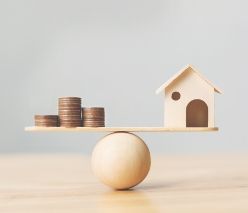30-Year Fixed-Rate Mortgage The traditional 30-year fixed-rate mortgage has a constant interest rate and principal payments that never change (taxes and insurance payments will likely change over the course of the loan). This may be a good choice if you plan to stay in your home for seven years or longer. If you plan to move within seven years, then adjustable rate loans are usually cheaper. As a rule of thumb, it may be harder to qualify for fixed-rate loans than for adjustable rate loans. When interest rates are low, fixed-rate loans are generally not that much more expensive than adjustable rate mortgages and may be a better deal in the long run, because you can lock in the rate for the life of your loan.
15-Year Fixed-Rate Mortgage This type of home mortgage loan is fully amortized over a 15-year period and features constant monthly payments. It offers all the advantages of the 30-year loan, plus a lower interest rate—and you’ll pay off your mortgage twice as fast. The disadvantage is that with a 15-year loan you commit to a higher monthly payment. Many borrowers opt for a 30 year fixed rate loan and voluntarily make larger payments that will pay off their loan in 15 years. This approach is often safer than committing to a higher monthly payment since the difference in interest rates isn’t that great.
Adjustable Rate Mortgages (ARM) When it comes to ARMs there’s a basic rule to remember: The longer you ask the lender to charge you a specific rate, the more expensive the loan.
Hybrid ARM (3/1 ARM, 5/1 ARM, 7/1 ARM) These increasingly popular types of home mortgage loans, also called 3/1, 5/1 or 7/1, can offer the best of both worlds: lower interest rates (like ARMs) and a fixed payment for a longer period of time than most adjustable rate loans. For example, a 5/1 loan has a fixed monthly payment and interest rate for the first five years and then turns into a traditional adjustable rate loan, based on then-current rates for the remaining 25 years. It’s a good choice for people who expect to move (or refinance) before or shortly after the adjustment occurs.
2/1 Buy Down Mortgage The 2/1 Buy Down Mortgage allows the borrower to qualify at below market rates so they can borrow more. The initial starting interest rate increases by 1% at the end of the first year and adjusts again by another 1% at the end of the second year. It then remains at a fixed interest rate for the remainder of the loan term. Borrowers often refinance at the end of the second year to obtain the best long-term rates. However, keeping the loan in place even for three full years or more will keep their average interest rate in line with the original market conditions.
Annual ARM This type of home mortgage loan has a rate that is recalculated once a year.
Monthly ARM With this loan, the interest rate is recalculated every month. Compared to other options, the rate is usually lower on this ARM because the lender is only committing to a rate for a month at a time, so vulnerability is significantly reduced.
Negative Amortization Loan This is a deferred-interest loan which is very powerful, but also the most misunderstood mortgage program because of its many options. Basically, the lender allows the borrower to make monthly payments that are less than the accruing interest. Therefore, if the borrower chooses to make the minimum monthly payment, the loan balance will increase by the amount of interest not paid on the loan. The power of this loan lies in the borrower’s ability to choose between making the full loan payment, the minimum payment or any amount in between. If a borrower’s income varies throughout the year (due to commissions, bonuses, etc.), the borrower can make a lower payment during the “lean times” and make higher payments when funds are readily available.
Balloon Mortgage A Balloon Mortgage is a mortgage which does not fully amortize over the term of the note, thus leaving a balance due at maturity. The final payment is called a balloon payment because of its large size. A Balloon Payment Mortgage may have a fixed or adjustable interest rate.
Reverse Mortgage A Reverse Mortgage is a loan that enables senior homeowners, age 62 and older, to convert part of their home equity into tax-free* income without having to sell their home, give up title to it or make monthly mortgage payments. The loan only becomes due when the last borrower(s) permanently leaves the home. * Consult Tax Advisor. Now that you’ve read about the types of home mortgage loans we offer in Las Vegas and Reno, NV, we welcome the opportunity to speak further with you. Call our team today to discuss loan details and complete an application 